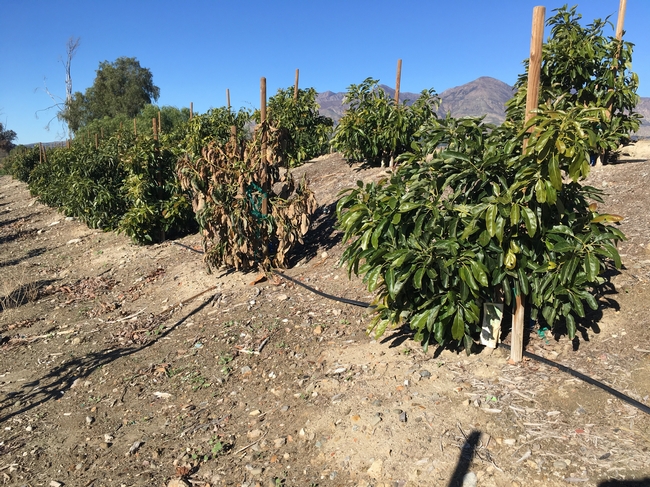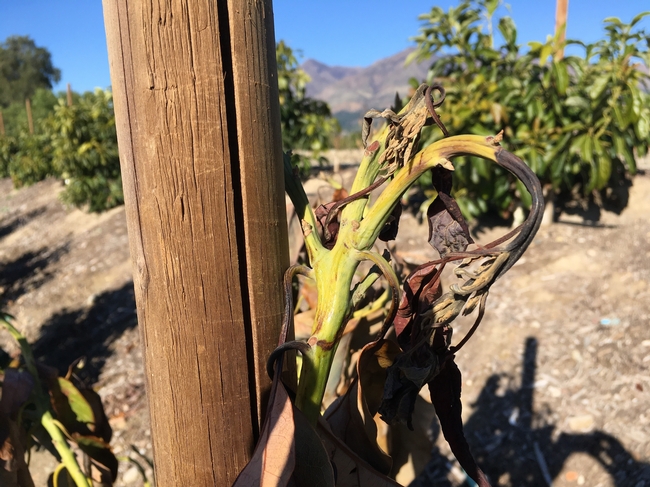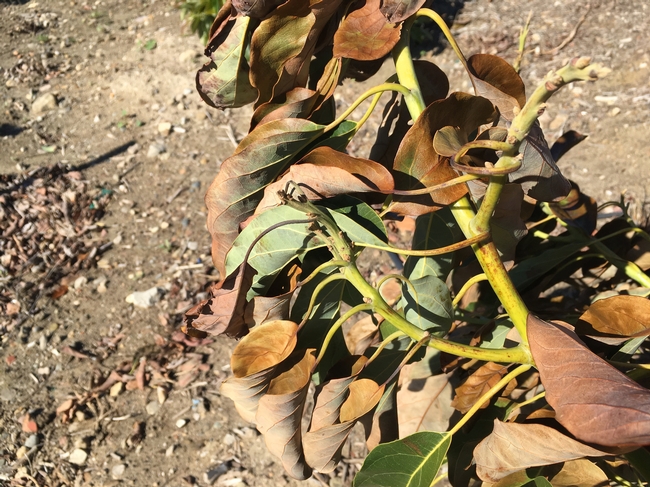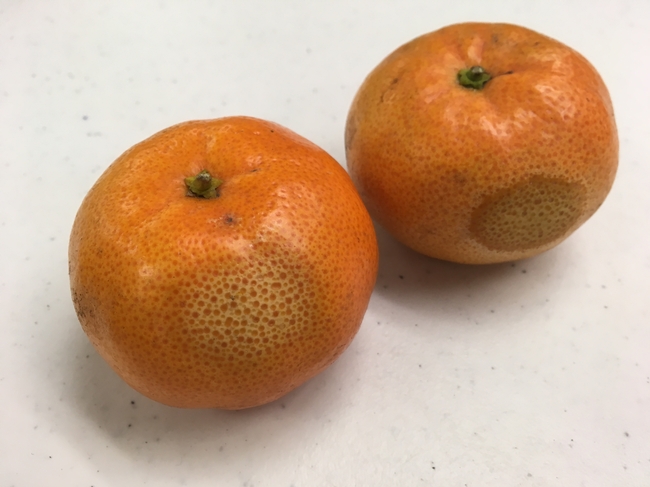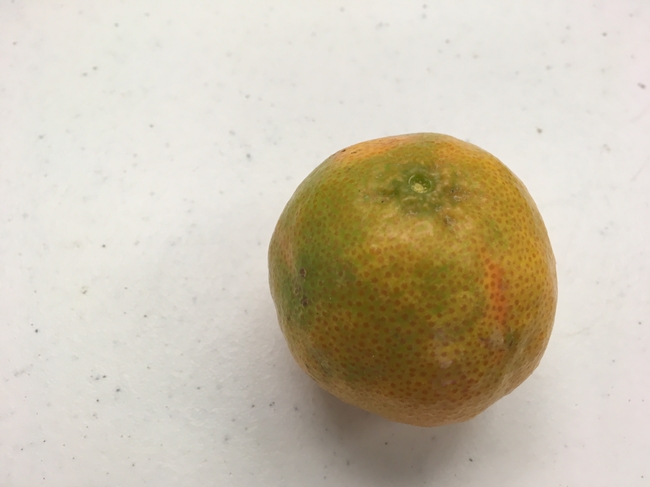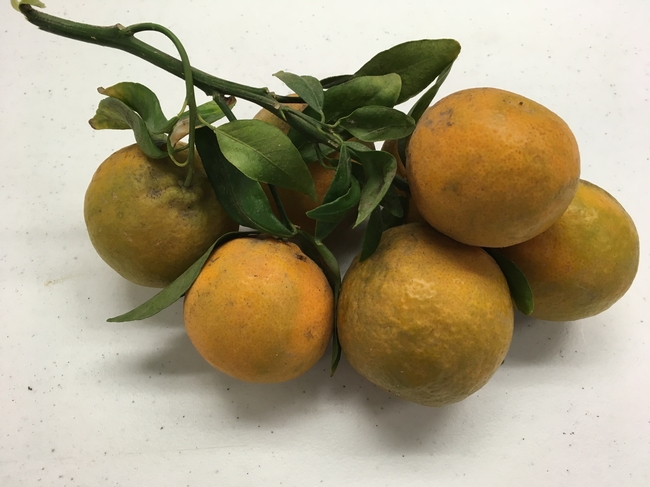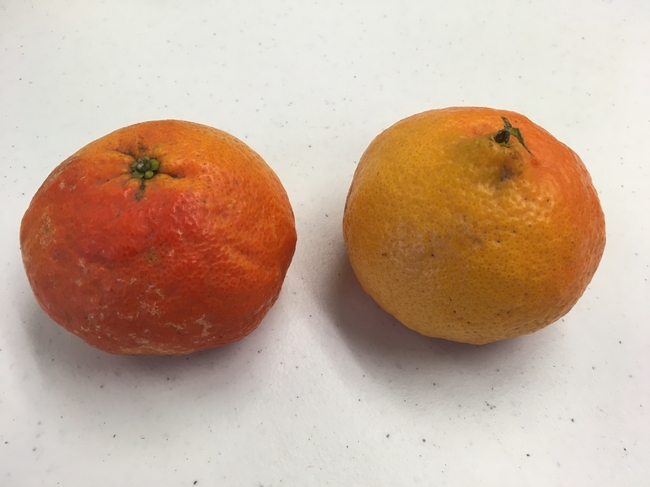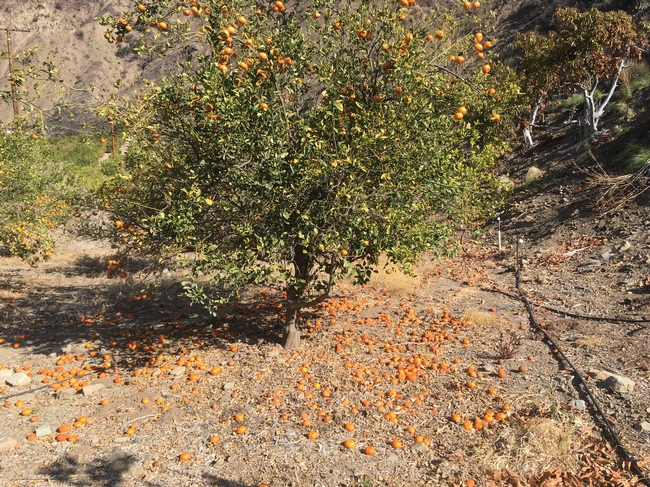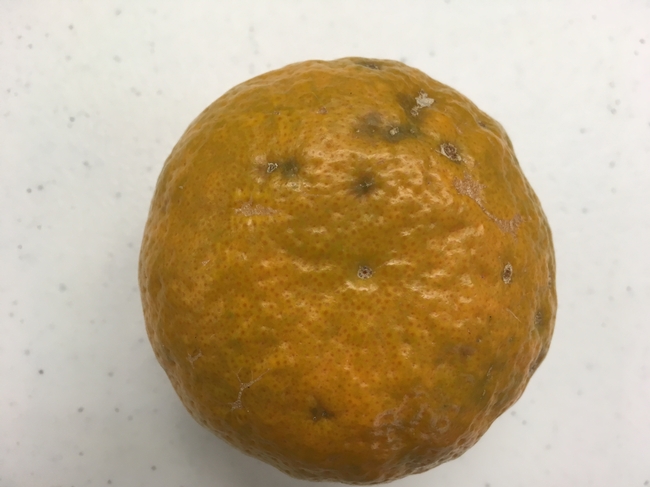
Posts Tagged: abiotic
Why O Why, One Tree???
It's winter time and avocados and other subtropicals are prone to frost damage. Little trees especially that haven't developed a canopy that can trap heat are the most prone. So it gets cold and all the orchard looks fine, but there's one tree that doesn't look right and in a couple of days it really stands out.
Here's an example of a year old tree that turned brown and it actually looks like it was doing better than the trees surrounding. It's bigger and has a fuller canopy..... or at least it did.
But there's all the symptoms of frost damage - bronzed leaves and dead tips.
A week after the cold weather, there is already sunburn damage on the exposed stems. See the brown spots on the upper fork? That will soon turn all brown and dry up.
This is still a healthy tree with green stems, in spite of the burned leaves. Now is the time to protect the tree from sunburn damage. This is what can kill the little tree. Time to white wash it.
Why did it happen to this one tree? Maybe it was a little bigger and needed more water than the surrounding trees. Maybe sitting on a rock and didn't have enough rooting volume for water. Maybe a touch of root rot (although the roots looked pretty good even for winter time). And there were ground squirrels in the area. Easy to bklamne them.
Listen to the sound of winter frost control
https://www.youtube.com/watch?v=rwTJveN8cIE
And when freeze damage gets extreme
https://ucanr.edu/blogs/blogcore/postdetail.cfm?postnum=16448
Not Just Navels Split
It has been a struggle to get through these hot times and now it's getting cooler, it's even rained, and suddenly that beautiful citrus that has just broken color and is an orange globe splits. It's most common in navels, but all citrus that ripen in the fall – tight-skinned satsuma mandarins, early clementines, tangelos and blood oranges. With the hot summer, it seems that a lot of citrus fruit have accelerated their maturity and are ready, ripe and sweet right now, and maybe ready to split.
And that's the problem. Drought stress. Salt stress due to drought. Water stress due to miserly watering. A heat wave in July. And a weird fall with maybe rain and maybe no rain and is ¼ inch considered rain or just a dedusting? Irregular watering is the key to splitting this time of year. The sugar builds, the pressure to suck in water builds and the fruit has been held back by a constrained water pattern and suddenly some water comes and it goes straight to the fruit and Boom, it splits.
Years of drought, and a stressed tree are a perfect set up for a citrus splitting in fall varieties like navel and satsuma. The days have turned cooler and there's less sense on the part of the irrigator to give the tree water and suddenly out of nowhere, there is rain. That wonderful stuff comes down and all seems right with the world, but then you notice that the mandarin fruit are splitting. Rats? Nope, a dehydrated fruit that has taken on more water than its skin can take in and the fruit splits. This is called an abiotic disorder or disease. However, it's not really a disease, but a problem brought on by environmental conditions. Or poor watering practices.
Fruit that is not yet ripe, like ‘Valencias' and later maturing mandarins are fine because they haven't developed the sugar content and have a firmer skin. They then develop during the rainy season when soil moisture is more regular. Or used to be more regular. With dry, warm winters this may become more or a problem in these later varieties, as well.
Several factors contribute to fruit splitting. Studies indicate that changes in weather, including temperature, relative humidity and wind may exaggerate splitting. The amount of water in the tree changes due to the weather condition, which causes the fruit to shrink. Then with rewetting, the fruit swells and bursts. In the navel orange, it usually occurs at the weakest spot, which is the navel. In other fruit, like blood orange, it can occur as a side split, as seen in the photo below.
Proper irrigation and other cultural practices can help reduce fruit spitting. Maintaining adequate but not excessive soil moisture is very important. A large area of soil around a tree should be watered since roots normally grow somewhat beyond the edge of the canopy. Wet the soil to a depth of at least 2 feet, then allow it to become somewhat dry in the top few inches before irrigating again. Applying a layer of coarse organic mulch under the canopy beginning at least a foot from the trunk can help moderate soil moisture and soil temperature variation.
Once split, the fruit is not going to recover. It's best to get it off the tree so that it doesn't rot and encourage rodents.
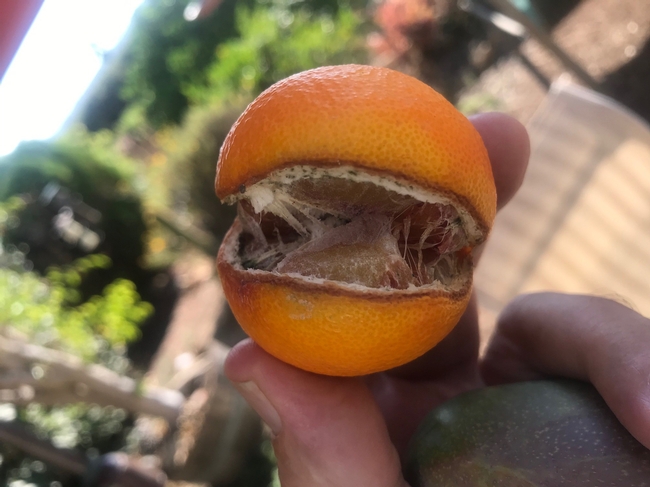
blood orange split
Stones in Avocado Fruit
The English often call a fruit seed other names, like pip. A large pit could be called a stone. Avocado usually has a seed, and if not it turns out to be a small fruit, called a "cuke". Well that's a different story. Sometimes little hard stones form in the flesh that are unrelated to germination. These stones are unpredictable and uncommon. A friend has said that if an avocado gives you a stone, turn it into a pearl. These stones are that rare. Art Schroeder from UCLA described them without much attribution to their cause, but gave them a good name - sclerocarpelosis. You can read his description in the 1981 California Avocado Society Yearbook which is available at Avocado Source:
http://www.avocadosource.com/CAS_Yearbooks/CAS_65_1981/CAS_1981_PG_125-132.pdf
Sclerocarpelosis in Avocado Fruit
C. A. Schroeder
Department of Biology, University of California, Los Angeles.
A rather unusual case of malformation in avocado fruit has been noted recently. The
aberrant tissue structure is not detectable from external examination of the fruit. Upon
cutting the mature or nearly mature fruit, the aberrant tissue becomes evident in the
form of a stony layer of various degrees of development located in the otherwise soft
fleshy pericarp wall. A tentative name of sclerocarpelosis is used to describe this
condition. The term sclero refers to hardness of the stone cells, or sclereids, which are
the basic structural elements involved. Carpel refers to the fruit wall, and osis implies a
disease or disturbance of the plant or plant tissue.
The fruit is sometimes affected to an extent that it becomes inedible. Still other fruits
may contain small clusters of stone cells which would not be detected even if eaten.
Extremely affected fruits can have a stony layer 1 to 5 mm in thickness completely
surrounding the seed. This structure is suggestive in many ways of a peach pit which
envelops the peach seed.
The affected fruits have been observed on several trees at various locations in a very
large (1300 acres) avocado planting in Orange County, California. The orchards
involved are situated on gently rolling hills. The major portion of the trees bearing
abnormal fruits are found in low elevations or "pockets" where the effects of local
radiation frosts were observed to severely affect the trees during the 1979-80 winter
season. Many of the trees exhibited responses to frost injury such as unusual resprouts
and development of main structural limbs at points near the soil, severe bark and
sunburn injury due to unusual exposure as the result of loss of leaf canopy by frost, and
a general weakened appearance of the entire tree in comparison with nearby unaffected
trees.
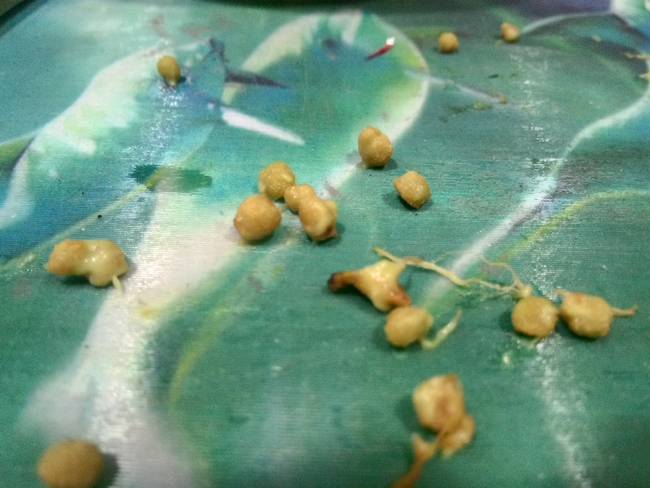
avocado stones
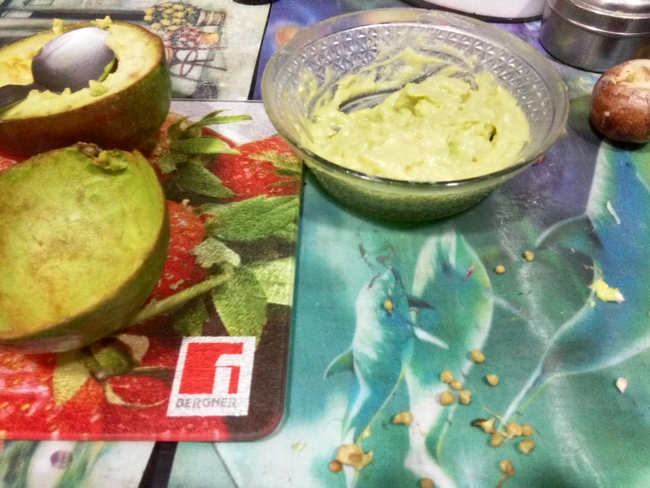
avocdo stones removed
Hot Mandarins. What to Look forward to After a Fire
Mandarins, also known as “zipper skins” and “easy peelers” can have very fragile peels/skins/rinds/exocarp that make them easily subject to more damage than most oranges and lemons. Some are a bit tougher skinned than others, but some are so fragile that any rough handling often prevents them from going through conventional packing operations.
These skins were recently put to the test in the recent fires in Ojai. There was a mix of different varieties - ‘Pixie', ‘Gold Nugget', ‘W. Murcott', ‘Yosemite Gold', ‘Tahoe Gold' and others. Some of them were more sensitive than others, some were closer to the fire, all were affected by smoke to some degree. In Matilija Canyon where smoke was present for many more days than in the east of the Ojai Valley and possibly more ash, the trees have started flowering sooner. That might be temperature difference, either cooler or warmer, so it is hard to say how much effect the smoke has had versus, the ash and/or heat. Smoke has many different gasses in it, one of which is ethylene which is a naturally occurring ripening agent. Smoke not only has gasses, but it occludes the sun so less or more or altered light might have an effect on these fruit. It's not a controlled experiment, so some little scientist is going to have to come along and wriggle out these different effects. Whatever. Fire and smoke have an effect on mandarins as we have seen in other crops, such as cherimoya, avocados and other citrus.
Heat damage. Fruit facing the fire.
Ash effects on fruit coloring. Fruit was covered with ash for several days until rain washed it off. Might be a pH effect (ash is alkaline), temperature effect, uneven light radiation, or other…….
Same sort of uneven coloring, that actually looks like an ashy color, but the ash has washed off the cluster by rain
And here's something interesting where fruit facing the fire is much lighter colored than fruit facing away from the fire. Here are two pieces of fruit, one from the side directly facing the fire, and the other from the other side of the tree. The side of that fruit facing the fire was also lighter colored. So, it had an effect through the canopy (small tree). The canopy was otherwise intact, unaffected heat or flames.
Oh yeah, and there is the characteristic fruit drop from either the heat, smoke gases, water stress or ….
And then there's the fruit that looks like it had actual embers on the skin.
If the tree survives and keeps its green leaves, sometimes the fruit is affected in ways that don't appear for a while. The peel may be affected, but in many cases the fruit is just as sweet as it could be. It just looks terrible. That might even be a selling point. "Here have a wonderous piece of history that braved the horror of the Ojai fires."
Satsumas and Navels - Too Late?
There have been some complaints about satsuma mandarin fruit having problems. These are prone to a rind/skin/peel breakdown when the fruit is not picked promptly. It's not clear what the cause is - wet winter, warm winter - but it is less of a problem if the fruit is picked when it is mature. A lot of the time in southern California, satsumas will develop good flavor and sweetness, but for lack of cool weather, they don't turn bright orange, a hallmark of the fruit. So growers will leave the fruit on longer, hoping for color, but the fruit becomes over mature, and more susceptible to breakdown. This weakening of the peel then opens it up to infection by fungi, such as Alternaria. In warm winters, the peel matures more rapidly and is more susceptible. Early maturing varieties like ‘Okitsuwase' are especially prone to breakdown later in the season, since their rind matures earlier. They end up being a mess, as can be seen in the photo below.
Navels can have a similar problem in these winters with erratic rainfall. Common wisdom is you don't irrigate in the winter, right? Wrong. With no, low and widely spaced rain events, the tree roots dry out, and rewet with rain. Navels are building their sugar in the winter and they become suction balls for water as the sugar increases. The fruit will continue to grow as the tree takes up water. When the roots run out of water, and then are suddenly rewetted during this period, the fruit can suck up water so rapidly that the skin cant expand fast enough and will split. So this is what happens with uneven irrigation or rainfall this time of year. One of those abiotic problems in citrus.

satsuma rind breakdown

split navels

